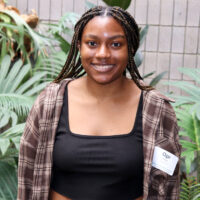
Grafting plants and knowledge: Affixing rootstock to scion and joining local expertise with scientific knowledge to enhance plant performance and public engagement in science
Utilizing the non-traditional research approach of community-based participatory research (CBPR), members of a local community collaborate with scientists to identify and address issues collectively. This approach supplements scientific knowledge with the community’s local expertise, which informs the research process as the issue is investigated. I conducted a literary analysis using grounding theory to ascertain whether the barriers to CBPR identified in existing literature are applicable in the context of plant science.. Drawing from my experience in the Frank lab, I conducted focus groups involving fellow REU interns, members of the Frank lab, and farmers based in Ithaca. The aim was to gauge interest levels in CBPR participation and identify specific CBPR barriers relevant to plant biology. Through these discussions, we also uncovered potential solutions to these barriers. Notably, I found that the most efficient way to mitigate these barriers to CBPR includes building infrastructure in research institutions and funding organizations to both incentivize and support CBPR. Grafting, a longstanding horticultural practice, has been utilized for its benefits in stress resistance and crop breeding. However, the current timeline of the restoration of symplastic transport during the graft healing process and the role of plasmodesmata (PD) channels in wave signal propagation are currently unknown. I aimed to establish a timeline of PD formation during graft healing, utilizing fluorescent proteins GFP and TdTom to image secondary PD density under a confocal microscope. I identified potential GFP and TdTom-tagged tomato plant lines suitable for grafting and subsequent imaging. To investigate the correlation between secondary PD density and wave signal intensities, I identified and activated inducible callose tomato lines that closed the PD in regions treated with estradiol externally.
This summer provided me with the opportunity to take on projects that investigate the intersection between biology and the social sciences. Not only did I gain technical lab skills, but I also gained invaluable experiences engaging with the local Ithaca community for my research. Over these ten weeks, I got a taste of being a graduate student, which helped me refine my plans for my graduate-level education. I learned about the diverse career paths that research could lead to, in addition to growing as a budding scientist. I want to thank to the Frank lab, especially my mentor Elise Boisvert, and Dr. Bruce Lewenstein for all their guidance with my project!
